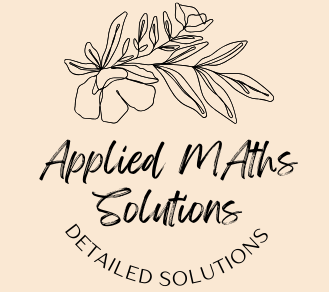Welcome to Class 11 Applied Maths Chapter 6, where we embark on an exciting journey into the world of advanced mathematical concepts tailored for Class 11 students.” Unlock the power of applied mathematics with expert solutions crafted by professionals at AppliedMath.com. Designed to propel students towards academic success, our meticulously curated ML Aggarwal Solutions for Applied Mathematics cater to Class 11 and class 12 students seeking mastery in their examinations. Every query from the CBSE ML Aggarwal Books finds a comprehensive answer on our platform, complete with detailed explanations and step-by-step solutions presented in an easily understandable language.
Dive into the world of applied mathematics and discover how our resources can elevate your understanding and performance. Keep reading to explore the wealth of ML Aggarwal Solutions for Class 11 and Class 12 Applied Mathematics.
Here we provide you with Class 11 Applied Maths Chapter 6, to help you gain a comprehensive understanding of the chapter and its concepts. https://appliedmathsolution.com/wp-admin/post.php?post=6&action=edit

Class 11 Applied Maths Chapter 6 Solutions
Sequences and Series
EXERCISE- 6.1
Q.1 Give an example of a sequence which is not a progression.
Ans. Example which is not a progression,
Therefore, taking prime numbers = 2,3, 5, 7, 11…..
Q.2 If a sequence is given by a1 =2, a2 = 3 + a1 and an = 2a(n-1) – 1 for n > 2. Then write the corresponding series upto 4 terms.
Ans. a1 = 2
a2 = 3 + a1
= 3 + 2 = 5
a3 = 2 x a(3-1) – 1
= 2 x a2 – 1
= 2 x 5 – 1 = 9
a4 = 2 x a(4-1) – 1
= 2 x a3 – 1
= 2 x 9 – 1 = 17
Series = 2 + 5 + 9 + 17.
Q.3 Write first 5 terms of the following sequences whose nth terms are given by:
(i) an = 2n + 5 (ii) an = n(n – 1) (iii) an = 2^n (iv) an = (n^2 + 1)/(2n – 3)
Ans.
(i) an = 2n + 5
a1 = 2 x 1 + 5 = 7
a2 = 2 x 2 + 5 = 9
a3 = 2 x 3 + 5 = 11
a4 = 2 x 4 + 5 = 13
a5 = 2 x 5 + 5 = 15
(ii) an = n(n – 1)
a1 = 1(1 – 1) = 1 x 1 = 0
a2 = 2( 2 – 1) = 2 x 1 = 2
a3 = 3(3 – 1) = 3 x 2 = 6
a4 = 4(4 – 1) = 4 x 3 = 12
a5 = 5(5 – 1) = 5 x 4 = 20
(iii) an = 2^n
a1 = 2^1 = 2
a2 = 2^2 = 4
a3 = 2^3 = 8
a4 = 2^4 = 16
a5 = 2^5 = 32
(iv) an = (n^2 + 1)/(2n – 3)
a1 = (1^2 + 1)/(2×1 – 3)
=(1 + 1)/(2 – 3)
= 2/-1
a2 = (2^2 + 1)/(2×2 – 3)
=(4 + 1)/(4 – 3)
= 5/1
a3 = (3^2 + 1)/(2×3 – 3)
=(9 + 1)/(6 – 3)
= 10/3
a14 = (4^2 + 1)/(2×4 – 3)
=(16 + 1)/(8 – 3)
= 17/5
a5 = (5^2 + 1)/(2×5 – 3)
=(25 + 1)/(10 – 3)
= 26/7
Q.4 Find the indicated term (s) in each of the following sequences whose nth terms are:
(i) an = 4n – 3; a17, a24 (ii) an = (-1)^n-1 n^3; a9
Ans.
(i) an = 4n – 3; a17, a24
a17 = 4 x 17 – 3
= 68 – 3 = 65
a24 = 4 x 24 – 3
= 96 – 3 = 93
(ii) an = (-1)^n-1 n^3; a9
a9 = (-1)^(9-1) x 9^3
= (-1)^8 x 729
= 1 x 729 = 729
Q.5 Find the first five terms of each of the following sequences and obtain the corresponding series:
(i) a1 = 1, an = a(n-1) + 2, n ≥ 2
(ii)a1 = 3, an = 3a(n-1) + 2, for all n > 1
Ans.
(i) a1 = 1, an = a(n-1) + 2, n ≥ 2
a1 = 1
an = a(n-1) + 2
a2 = a(2-1) + 2
= a1 + 2
= 1 + 2 = 3
a3 = a(3-1) + 2
= a2 + 2
= 3 + 2 = 5
a4 = a(4-1) + 2
= a3 + 2
= 5 + 2 = 7
a5 = a(5-1) + 2
= a4 + 2
= 7 + 2 = 9
Series = 1 + 3 + 5 + 7 + 9
(ii)a1 = 3, an = 3a(n-1) + 2, for all n > 1
a1 = 3
an = 3a(n-1) + 2
a2 = 3 x a(2-1) + 2
= 3 x a1 + 2
= 3 x 3 + 2 = 11
a3 = 3 x a(3-1) + 2
= 3 x a2 + 2
= 3 x 11 + 2 = 35
a4 = 3 x a(4-1) + 2
= 3 x a3 + 2
= 3 x 35 + 2 = 107
a5 = 3 x a(5-1) + 2
= 3 x a4 + 2
= 3 x 107 + 2 = 323
Series = 3 + 11 + 35 + 107 + 323
Q.6 If the sum of n terms of a sequence is given by Sn = 2n^2 + 3n for all n ∊ N, find the first four terms. Also find its 20th term.
Ans. Sn = 2n^2 + 3n
S1 = 2 x 1^2 + 3 x 1
= 2 + 3 = 5
S2 = 2 x 2^2 + 3 x 2
= 8 + 6 = 14
S3 = 2 x 3^2 + 3 x 3
= 18 + 9 = 27
S4 = 2 x 4^2 + 3 x 4
= 32 + 12 = 44
an = Sn – S(n-1)
a4 = S4 – S(4-1)
= S4 – S3
a4 = 44 – 27 = 17
a3 = S3 – S2
= 27 – 14 = 13
a2 = S2 – S1
= 14 – 5 = 9
a1 = S1 – S0
= 5 – 0 = 5
S1 = a1
Series = 5, 9, 13, 17…..
a20 = a + 19d
= 5 + 19 x 4
= 81
Q.7 First term of a sequence is 1 and the (n + 1)Th terms is obtained by adding (n + 1) to the nth term for all the natural numbers n. Find the sixth term of the series.
Ans. a1 = 1
a(n+1) = an + (n + 1)
Put n = 1,
a(1+1) = a1 + (1 + 1)
a2 = 1 + 2 = 3
Put n = 2,
a(2+1) = a2 + (2 + 1)
a3 = 3 + 3 = 6
Put n = 3,
a(3+1) = a3 + (3 + 1)
a4 = 6 + 4 = 10
Put n = 4,
a(4+1) = a4 + (4 + 1)
a5 = 10 + 5 = 15
Put n = 5,
a(5+1) = a5 + (5 + 1)
a5 = 15 + 6 = 21
FAQ’s related to Class 11 Applied Maths Chapter 6 on Sequences and Series:
Q.1 What is a sequence?
Ans. A sequence is an ordered list of numbers following a particular pattern. Each number in a sequence is called a term.
Q.2 What is a series?
Ans. A series is the sum of the terms of a sequence. If we add the terms of a sequence, we get a series.
Q.3 What is the difference between an arithmetic sequence and a geometric sequence?
Ans.
- Geometric Sequence – A geometric sequence (or geometric progression) is a sequence in which each term is obtained by multiplying the previous term by a fixed, non-zero number called the common ratio (r).
- Arithmetic Sequence – An arithmetic sequence (or arithmetic progression) is a sequence in which the difference between consecutive terms is constant. This difference is called the common difference (d).
These are a few Frequently Asked Questions relating to Class 11 Applied Maths Chapter 6
In Class 11 Applied Maths chapter 6, you will explore fascinating topics that form the backbone of practical problem-solving techniques. Through clear explanations, illustrative examples, and step-by-step solutions, you’ll grasp complex concepts effortlessly. Whether you’re preparing for exams or simply eager to deepen your mathematical understanding, Class 11 Applied Maths Chapter 6 promises an enriching learning experience that will set you on the path to success. Class 11 Applied Maths Chapter 6, we delve deep into advanced mathematical concepts that are crucial for understanding.
Class 11 Applied Maths Chapter 6 Exercise :


Nice explanation 👍🙏👌👌
Thank You..!!
Thank you so much for the solutions !!!😊
It’s my pleasure !!